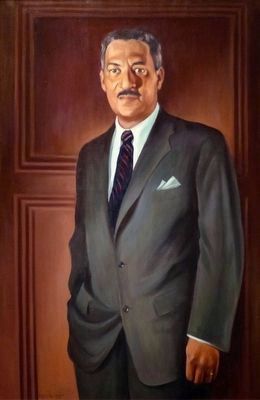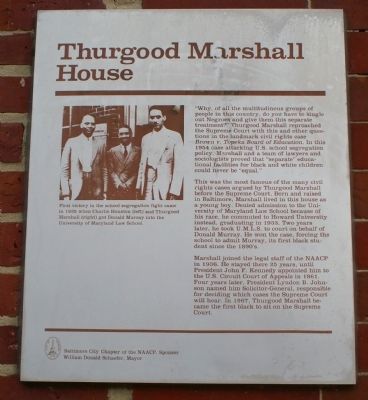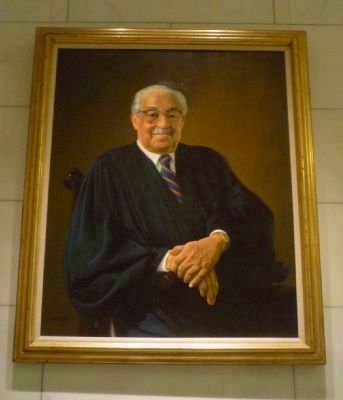Upton in Baltimore, Maryland — The American Northeast (Mid-Atlantic)
Thurgood Marshall House
This was the most famous of the many civil rights cases argued by Thurgood Marshall before the Supreme Court. Born and raised in Baltimore, Marshall lived in this house as a young boy. Denied admission to the University of Maryland Law School because of his race, he commuted to Howard University instead, graduating in 1933. Two years later, he took U.M.L.S. to court on behalf of Donald Murray. He won the case, forcing the school to admit Murray, its first black student since the 1890's.
Marshall joined the legal staff of the NAACP in 1936. He stayed there 25 years, until President John F. Kennedy appointed him to the U.S. Circuity Court of Appeals in 1961. Four years later, President Lyndon B. Johns named him Solicitor-General, responsible for deciding which cases the Supreme Court will hear. In 1967, Thurgood Marshall became the first black to sit on the Supreme Court.
Erected by the City of Baltimore, Baltimore City Chapter of the NAACP, Sponsor and William Donald Schaefer, Mayor.
Topics and series. This historical marker is listed in these topic lists: African Americans • Civil Rights • Education. In addition, it is included in the Former U.S. Presidents: #35 John F. Kennedy, the Historically Black Colleges and Universities, and the Maryland, Baltimore City historical markers series lists. A significant historical year for this entry is 1954.
Location. 39° 18.25′ N, 76° 38.009′ W. Marker is in Baltimore, Maryland. It is in Upton. Marker is on Division Street, on the left when traveling north. Touch for map. Marker is at or near this postal address: 1632 Division Street, Baltimore MD 21217, United States of America. Touch for directions.
Other nearby markers. At least 8 other markers are within walking distance of this marker. Community Growth and Faith (within shouting distance of this marker); Diversity in a Segregated Community (about 400 feet away, measured in a direct line); Nurturing the Arts (about 400 feet away); Buy Where You Can Work Campaign & Higher Education (about 500 feet away); Building Community Organizations (about 500 feet away); Suffrage Leaders (about 600 feet away); Take a Stroll Down the Main Street of the African American Experience
(about 600 feet away); J. Howard Payne (1887-1960) House (approx. 0.2 miles away). Touch for a list and map of all markers in Baltimore.
More about this marker. The marker features a photograph with the caption:
First victory in the school segregation fight came in 1935 when Charlie Houston (left) and Thurgood Marshall (right) got Donald Murray into the University of Maryland Law School.

Photographed By Allen C. Browne, February 16, 2015
4. Thurgood Marshall
This 1956 portrait of Thurgood Marshall by Betsy Graves Reyneau hangs in the National Portrait Gallery in Washington, DC.
“Thurgood Marshall played a major role in the 1940s and 1950s as a leader in the struggle to end racial discrimination in the United States. From 1938 to 1961, he served as chief staff lawyer for the NAACP. Marshall devoted much effort to tailoring arguments that led the Supreme Court to its unanimous 1954 Brown v. the Board of Education of the City of Topeka decision, which ruled segregation of public schools by race to be unconstitutional. But he realized the struggle was not over. At a party celebrating the Brown decision, Marshall warned his colleagues, ‘I don't want any of you to fool yourselves, it's just begun; the fight has just begun.’ He went on to become the first African American Supreme Court justice, nominated by President lyndon Johnson in 1967.” — National Portrait Gallery
“Thurgood Marshall played a major role in the 1940s and 1950s as a leader in the struggle to end racial discrimination in the United States. From 1938 to 1961, he served as chief staff lawyer for the NAACP. Marshall devoted much effort to tailoring arguments that led the Supreme Court to its unanimous 1954 Brown v. the Board of Education of the City of Topeka decision, which ruled segregation of public schools by race to be unconstitutional. But he realized the struggle was not over. At a party celebrating the Brown decision, Marshall warned his colleagues, ‘I don't want any of you to fool yourselves, it's just begun; the fight has just begun.’ He went on to become the first African American Supreme Court justice, nominated by President lyndon Johnson in 1967.” — National Portrait Gallery
Credits. This page was last revised on April 17, 2020. It was originally submitted on March 15, 2008, by Christopher Busta-Peck of Shaker Heights, Ohio. This page has been viewed 4,923 times since then and 68 times this year. Last updated on March 26, 2008, by Richard E. Miller of Oxon Hill, Maryland. Photos: 1, 2. submitted on March 15, 2008, by Christopher Busta-Peck of Shaker Heights, Ohio. 3. submitted on January 5, 2011, by Richard E. Miller of Oxon Hill, Maryland. 4. submitted on September 1, 2015, by Allen C. Browne of Silver Spring, Maryland.


